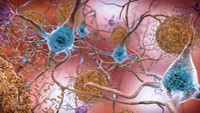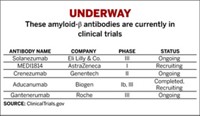Advertisement
Grab your lab coat. Let's get started
Welcome!
Welcome!
Create an account below to get 6 C&EN articles per month, receive newsletters and more - all free.
It seems this is your first time logging in online. Please enter the following information to continue.
As an ACS member you automatically get access to this site. All we need is few more details to create your reading experience.
Not you? Sign in with a different account.
Not you? Sign in with a different account.
ERROR 1
ERROR 1
ERROR 2
ERROR 2
ERROR 2
ERROR 2
ERROR 2
Password and Confirm password must match.
If you have an ACS member number, please enter it here so we can link this account to your membership. (optional)
ERROR 2
ACS values your privacy. By submitting your information, you are gaining access to C&EN and subscribing to our weekly newsletter. We use the information you provide to make your reading experience better, and we will never sell your data to third party members.
Environment
Alzheimer’s Treatment Dispute
Four teams can’t replicate 2012 study indicating that bexarotene reversed neurodegeneration in mice
by Lauren K. Wolf
June 10, 2013
| A version of this story appeared in
Volume 91, Issue 23

Early last year, a research team at Case Western Reserve University School of Medicine published remarkable results. The researchers, led by Gary E. Landreth, demonstrated that within a few weeks the cancer drug bexarotene restored memory to mice with symptoms of Alzheimer’s disease. And they reported that the drug cleared 50% of amyloid plaques—clumps of peptide thought to be one of the culprits in the neurodegenerative disorder—from the rodents’ brains in just three days (Science 2012, DOI: 10.1126/science.1217697).
“I’ve worked in neuroscience a lot of years, and I’ve never seen anything like it,” says Kevin M. Felsenstein, a neuropharmaceutical expert at the University of Florida College of Medicine. Clearing 50% of plaque from a brain “in three days was astonishing,” he says.
The news gave fresh hope to a field of research that hasn’t had much luck on the drug discovery front. No sooner had Science published the report than patients began calling physicians, and even Landreth, seeking access to bexarotene. The drug is already on the market for treating a type of skin cancer, and those with Alzheimer’s thought they could use it too.
But recently, a shadow fell over this bright new avenue of Alzheimer’s research. In its May 24 issue, Science published follow-up studies by four independent research teams that failed to replicate all the Case Western findings (2013, DOI: 10.1126/science.1233937; 10.1126/science.1234089; 10.1126/science.1235505; and 10.1126/science.1235809). Two of the teams did observe improvements in the cognitive performance of their mice. But none of the teams, including Felsenstein’s, saw a decrease in the clumps of amyloid-β peptide riddling the rodents’ brains.
Disputes have since broken out among the researchers over why the new experiments didn’t replicate all the original findings. The drug is already set for a clinical trial, but some of the scientists are calling for further validation studies first.
Landreth’s group originally decided to test bexarotene as an Alzheimer’s treatment because of the molecule’s ability to activate brain-cell proteins called nuclear receptors, some of which control how often a gene called APOE gets transcribed in a cell. When the gene is switched on, the transcription machinery pumps out apolipoprotein E, a macromolecule that combines with fatty compounds in the body to form tiny globules. Scientists think these particles play the role of housekeeper, soaking up some of the suspect amyloid-β peptide and clearing it from the brain.
So it stood to reason, Landreth says, that by increasing levels of apolipoprotein E, bexarotene could help reduce amyloid-β levels.
Two of the outside research teams saw a decrease in less aggregated versions of the peptide called soluble amyloid-β. But none of the four saw amyloid plaque removal from the brains of their mice. So bexarotene’s mechanism of action is still in question, Felsenstein contends.
In response, Landreth and coworkers point out that they didn’t see plaque reduction in all the mice they tested, particularly in the older ones with more aggressive Alzheimer’s symptoms (Science 2013, DOI: 10.1126/science.1234114). All the rodents in their studies, however, were better able to remember the way through a maze when treated with bexarotene. So the team says that plaque clearance and memory restoration don’t necessarily correlate.
“We concluded back then that plaques don’t matter,” Landreth tells C&EN. “So it’s a mystery to me why these other investigators have focused on the irreproducibility of plaque removal. It seems like they’re beating a dead horse.”
Plus, Landreth says, a lot of researchers now believe that the molecular species really to blame in Alzheimer’s are oligomers, a form of soluble amyloid-β. Landreth’s and two other teams measured a decrease in soluble amyloid-β.
This oligomer argument does hold water, says Bart De Strooper, one of the dissenting team leaders and a neuroscientist at Catholic University of Leuven, in Belgium. “But the emphasis in the original paper was on the spectacular plaque effects” in younger mice, he adds, which makes it seem as if Landreth is now backpedaling.
The scientists aren’t just disputing the plaque results. They’re also arguing over the behavioral results in the experiments.
Radosveta P. Koldamova and her group at the University of Pittsburgh saw improved memory in their mice, just as Landreth’s team did. So she believes the drug shouldn’t be discarded as an Alzheimer’s treatment simply because of the plaque data. Yet she acknowledges the main issue the other follow-up groups are grappling with: “If there is something that doesn’t hold, does that put the entire study into question?”
For his part, Landreth emphasizes the behavioral results: “Improvements in memory and learning are the central and perhaps only relevant end point for an Alzheimer’s drug,” he says.
Others note that the type of mice used in the original and follow-up studies are not optimal subjects for testing behavior, however. “We don’t know what to make of their behavior,” Felsenstein explains, because these mice are engineered to deposit amyloid-β in their brains, but they don’t deposit tau protein—another signature molecule of the disease that scientists believe ultimately causes nerve cell damage. “So these animals aren’t true models of Alzheimer’s,” he adds.
As far as why the four follow-up teams weren’t able to entirely replicate his group’s findings, Landreth says it’s not yet clear. But he does point out that all the groups except for Koldamova’s used a formulation of bexarotene differing from his team’s.
The Case Western researchers worked with a microcrystalline form of the drug that is sold as Targretin by Japan-based pharmaceutical firm Eisai. The other groups, claiming that Landreth’s 2012 experimental protocol was not clear, obtained pure bexarotene and dissolved it in various solvents.
In the end, “we just want to be cautious,” Felsenstein says. Physicians such as Sam Gandy of Mount Sinai Hospital, in New York City, have received requests from desperate patients for off-label prescriptions of bexarotene. But the drug has been approved only for short-term cancer therapy, so long-term dosing—which would presumably be required for Alzheimer’s treatment—could well be dangerous, Gandy says.
To prove bexarotene’s worth, Landreth will collaborate with St. Louis-based firm C2N Diagnostics to begin a Phase Ia clinical trial in August. Twelve healthy patients will receive either a low dose of bexarotene or a placebo to test whether the drug engages APOE and decreases amyloid-β.





Join the conversation
Contact the reporter
Submit a Letter to the Editor for publication
Engage with us on Twitter